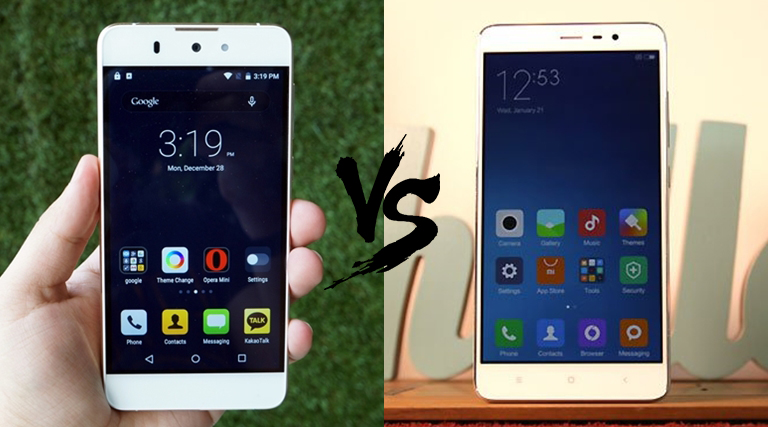Since the launch of the Touch ID on the iPhone 5s two years ago, the fingerprint scanner has become a popular feature among smartphones with most OEMs following suit. It started to become common among flagship devices and now, even mid-range smartphones already have it. Among the few available in the country are the Cherry Mobile Flare Selfie and the Xiaomi Redmi Note 3.
How do they fair against each other?

| Cherry Mobile Flare Selfie | Xiaomi Redmi Note 3 |
|---|---|
| 5-inch IPS LCD (1280 x 720 pixels), 294ppi | 5.5-inch IPS LCD, (1920 x 1080 pixels), 401ppi |
| 1.3GHz MediaTek MT6753 64-bit Octa-Core chipset | 2.0GHz MediaTek Helio X10 chipset |
| Mali-T720 GPU | PowerVR G6200 GPU |
| 3GB of RAM | 2GB/3GB of RAM |
| 16GB internal storage | 16GB/32GB internal storage |
| Expandable via microSD up to 32GB | Non-expandable memory |
| 16-megapixel BSI AF rear camera w/ dual-tone LED flash | 13-megapixel PDAF rear camera w/ dual-tone LED flash |
| 16-megapixel front camera | 5-megapixel front camera |
| Dual-SIM | Dual-SIM |
| 4G LTE | 4G LTE |
| Wi-Fi 802.11 a/b/g/n | Wi-Fi 802.11 ac |
| Bluetooth 4.0 | Bluetooth 4.1 |
| GPS w/ A-GPS, GLONASS | GPS w/ A-GPS, GLONASS, BDS |
| FM Radio | FM Radio |
| - | IR Blaster |
| Fingerprint scanner | Fingerprint scanner |
| 3000mAh battery, removable | 4000mAh battery, non-removable |
| Android 5.1 w/ Cherry Launcher | Android 5.0.2 w/ MIUI 7 |
| 143.4 x 69.4 x 7.99mm | 150 x 76 x 8.7mm |
Each of the devices has their own strengths. The Flare Selfie, being a camera-centric smartphone, has two 16-megapixel shooters both at the front and on its back. Obviously, it is marketed towards the crowd who likes to take selfies, thus the name of it. While the Redmi Note is more focused on being a big device with its 5.5-inch display, which also says much about its Note monicker.
Both are powered by MediaTek but with different chipsets. The Flare Selfie has a modest MT6753 while the Redmi Note 3 is powered by the beastly Helio X10 chipset. Despite this, both devices perform well with everyday task. The fingerprint scanners on their back are properly placed for easy use with the index finger. They are also quick to respond.
Memory-wise, the Flare Selfie has the edge with its 3GB RAM over the Redmi Note 3’s 2GB RAM but it also has a 3GB option. In terms of storage, the former has a 16GB internal storage but with an option for microSD expansion, while the latter has a fixed 16GB or 32GB.
Lastly, the price. The Cherry Mobile Flare Selfie will retail for just Php 7,999USD 136INR 11,555EUR 130CNY 993 starting next year while the Xiaomi Redmi Note 3 is currently listed on Widget City for Php 8,500USD 145INR 12,279EUR 138CNY 1,055 for 2GB/16GB and Php 10,500USD 179INR 15,168EUR 170CNY 1,303 for the 3GB/32GB option. We’re still working on our full written review on both devices, so be sure to check back soon.

YugaTech.com is the largest and longest-running technology site in the Philippines. Originally established in October 2002, the site was transformed into a full-fledged technology platform in 2005.
How to transfer, withdraw money from PayPal to GCash
Prices of Starlink satellite in the Philippines
Install Google GBox to Huawei smartphones
Pag-IBIG MP2 online application
How to check PhilHealth contributions online
How to find your SIM card serial number
Globe, PLDT, Converge, Sky: Unli fiber internet plans compared
10 biggest games in the Google Play Store
LTO periodic medical exam for 10-year licenses
Netflix codes to unlock hidden TV shows, movies
Apple, Asus, Cherry Mobile, Huawei, LG, Nokia, Oppo, Samsung, Sony, Vivo, Xiaomi, Lenovo, Infinix Mobile, Pocophone, Honor, iPhone, OnePlus, Tecno, Realme, HTC, Gionee, Kata, IQ00, Redmi, Razer, CloudFone, Motorola, Panasonic, TCL, Wiko
Best Android smartphones between PHP 20,000 - 25,000
Smartphones under PHP 10,000 in the Philippines
Smartphones under PHP 12K Philippines
Best smartphones for kids under PHP 7,000
Smartphones under PHP 15,000 in the Philippines
Best Android smartphones between PHP 15,000 - 20,000
Smartphones under PHP 20,000 in the Philippines
Most affordable 5G phones in the Philippines under PHP 20K
5G smartphones in the Philippines under PHP 16K
Smartphone pricelist Philippines 2024
Smartphone pricelist Philippines 2023
Smartphone pricelist Philippines 2022
Smartphone pricelist Philippines 2021
Smartphone pricelist Philippines 2020
Jakrems says:
Please enlighten me, di ko pa rin gets anong basehan bakit yang dalawang yan ang na-compare?
finaldata (@finaldata) says:
oo nga bakit?
Alduz Dumbledore says:
Agree. It should be compared with Asus Selfie phone, not RedMi note 3
vendeatha says:
’cause someone ask a comparison test between them.
john says:
16 megapixel talaga? Weh!!!
Daniel Imburnal says:
parang kwentong barbero lng ang review.. hahaha